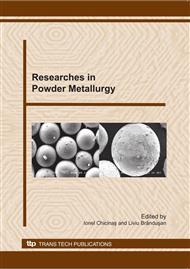p.297
p.303
p.307
p.311
p.315
p.319
p.323
p.327
p.331
Evaluation of Surface Integrity during Machining with Different Tool Grades of Sicp/Al-Si Composites Produced by Powder Metallurgy
Abstract:
MMCs components are mostly produced using near net shape manufacturing methods and are subsequently machined to the final dimensions and surface finishes. The MMCs consist of extremely hard reinforcing particles and pose considerable challenges due to the poor machinability and severe wear of the cutting tool. In this study, cutting performance of WC, CBN and PCD cutting tools were investigated with respect to surface roughness during machining of 10 wt % SiCp reinforced Al-Si alloy matrix composites produced by powder metallurgy (PM) method. Average surface roughness (Ra) corresponding to each machining condition was measured. After the machining process the worn insert tips were examined under the scanning electron microscope (SEM). Chip geometry and machined surface photographs have been taken by optical microscopy. The experimental results showed that surface roughness decreased with increasing cutting speed for all of cutting tool materials. The best surface integrity was occurred after the machining with PCD insert at the highest cutting speed employed.
Info:
Periodical:
Pages:
319-322
Citation:
Online since:
January 2011
Authors:
Price:
Сopyright:
© 2011 Trans Tech Publications Ltd. All Rights Reserved
Share:
Citation:


